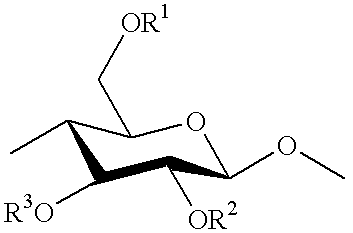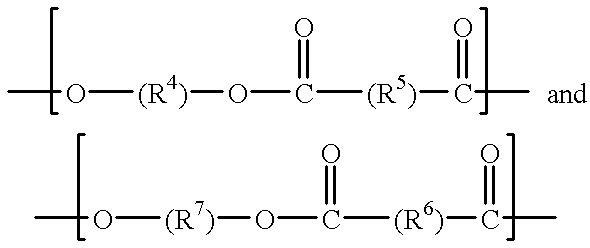Cellulose ester blends
a technology of cellulose ester and blend, which is applied in the direction of bandages, impression caps, applications, etc., can solve the problems of increasing the cost of solid waste disposal, reducing the number of available landfills, and a large amount of these disposable items
- Summary
- Abstract
- Description
- Claims
- Application Information
AI Technical Summary
Problems solved by technology
Method used
Image
Examples
example 1
Melt pressed films were prepared from blends of cellulose acetate of high degree (CA-H) and intermediate (CA-L) of substitution using polyethylene glycol-400 as a plasticizer according to general thermal method (i). This example illustrates the useful properties of these blends and demonstrates how a range of unexpectedly useful properties can be obtained by proper selection of the blend components. For example, a range of modulus from 2.4 to 1.3 is available without having to alter the plasticizer content and, even though the (CA-H) is the low modulus blend component, the softest film (low modulus) occurs when the blend composition is 50 / 50 CA-L / CA-H. Such a composition will degrade more rapidly than a 100% (CA-H).
example 2
This example demonstrates that shaped articles with dimensional stability can be made from these blends using the standard injection molding process and that resins with a wide range of properties can be obtained by proper selection of the blend ratio. For example, the 50 / 50 blend has a combination of unexpected high impact strength and low flexural modulus. Each of these blends consisted of cellulose acetate of intermediate DS (CA-L, DS=2.05) and high DS (CA-H, DS=2.5) with 24% polyethylene glycol-400 as plasticizer. The blend was prepared according to general thermal method (iv) using a processing temperature of 210.degree. C. and a molding temperature of 210.degree. C.
example 3
Composting can be defined as the microbial degradation and conversion of solid organic waste into soil. One of the key characteristics of compost piles is that they are self heating; heat is a natural by-product of the metabolic break down of organic matter. Depending upon the size of the pile, or its ability to insulate, the heat can be trapped and cause the internal temperature to rise.
In order to assess the biodegradation potential of the test films, small-scale compost units were employed to simulate the active treatment processes found in a municipal solid waste composter. These bench-scale units displayed the same key features that distinguish the large-scale municipal compost plants. The starting organic waste was formulated to be representative of that found in municipal solid waste streams: a carbon to nitrogen of 25:1 ratio, a 55% moisture content, a neutral pH, a source of readily degradable organic carbon (e.g., cellulose, protein, simple carbohydrates, and lipids), and ...
PUM
| Property | Measurement | Unit |
|---|---|---|
| temperature | aaaaa | aaaaa |
| weight % | aaaaa | aaaaa |
| mole % | aaaaa | aaaaa |
Abstract
Description
Claims
Application Information
 Login to View More
Login to View More - R&D
- Intellectual Property
- Life Sciences
- Materials
- Tech Scout
- Unparalleled Data Quality
- Higher Quality Content
- 60% Fewer Hallucinations
Browse by: Latest US Patents, China's latest patents, Technical Efficacy Thesaurus, Application Domain, Technology Topic, Popular Technical Reports.
© 2025 PatSnap. All rights reserved.Legal|Privacy policy|Modern Slavery Act Transparency Statement|Sitemap|About US| Contact US: help@patsnap.com



